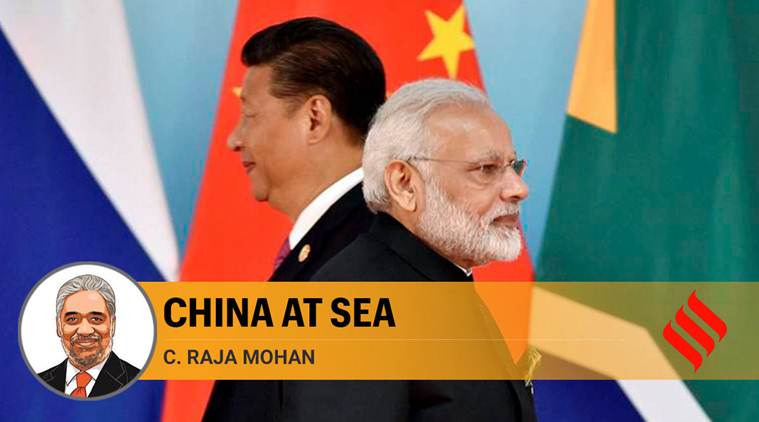- India
- International
China at sea: For Delhi, Shiyan incident is a reminder to invest more in maritime scientific research
With Beijing expanding strategic purpose of its marine research to Andamans, Delhi and its partners should coordinate maritime diplomacy.
 China has begun to extend it to the Indian Ocean. (File Photo)
China has begun to extend it to the Indian Ocean. (File Photo)
Recent reports that the Indian Navy “chased out” a Chinese vessel — Shiyan 1— from the Andaman Sea should draw Delhi’s attention to Beijing’s growing maritime scientific capabilities and its ambitious research agenda for distant waters. Shiyan 1 is operated by the Chinese Academy of Sciences and is part of Beijing’s growing marine research fleet that now stands at about 50 vessels.
Beijing’s expansive investment in marine scientific research is very much part of its rise as a great maritime power and dovetails into its regional strategies. After leveraging marine science diplomacy to good effect in the South China Sea over the last many years, China has begun to extend it to the Indian Ocean. Last year, Shiyan-3 invited Pakistan scientists to join a research expedition in the Arabian Sea. Delhi must expect to see more of this in the Indian Ocean littoral.
At his press conference last week, the Chief of Naval Staff, Admiral Karambir Singh confirmed that Shiyan 1 was operating near Port Blair and had neither taken prior permission from India nor did it inform the relevant Indian authorities of its plans. Admiral Singh said “our stand is that if you have to do anything in our region, you notify us or take our permission”. Reacting to the Indian statement, the Ministry of Foreign Affairs in Beijing said that China’s research vessel Shiyan 1 was indeed “conducting acoustic propagation experiments and hydrologic environment measurements on the high seas of the Indian Ocean”.
But, Beijing insisted that Shiyan 1, “did not conduct any operations in the Indian EEZ (exclusive economic zone) during the whole process, and only sailed through the Indian EEZ on the way to and from the experimental area”. The foreign office in Beijing added that throughout the ship’s voyage, the Indian navy aircraft followed it with warnings and its crew also replied in accordance with international practice.
The issue is not a technical one about the provisions of the law of the sea. It is about China’s growing maritime scientific ambition. To be sure, the UN Convention on the Law of the Sea (UNCLOS) favours freedom of marine scientific research. It also lets coastal states decide on granting permission for marine scientific research by other entities in their exclusive economic zones.

Beijing is not contesting that provision. It says it is merely asserting its rights. As the foreign ministry in Beijing put it, “China has always exercised the freedom of scientific research on the high seas in accordance with the law and fully respects the jurisdiction of relevant coastal states over their scientific research activities in the waters under their jurisdiction”. Beijing also expressed hope that Delhi will “take a correct view of China’s marine scientific research activities and avoid disturbing normal and lawful maritime activities.”
There are many grey areas in the law of the sea, including on the conduct of maritime scientific research in the waters that other states have sovereign control over. Great powers, rising or incumbent, tend to interpret international law to suit their interests and convenience. Weaker ones have no way of enforcing their rights under UNCLOS. More broadly, it is difficult to separate marine scientific research for peaceful and military purposes.
Shiyan 1 now operates as part of the so-called “national fleet” for marine scientific research. Earlier this decade, China brought together the marine research activities of multiple governmental agencies, ministries and commercial entities like oil companies under one administrative framework. The objective is to minimise duplication, enhance coordination and closely align research with larger maritime goals, civilian and military, set by the party-state.
In the past, China’s marine science research was confined to near seas in the Western Pacific. It now extends to seas all around the world. About half of the marine scientific fleet is reportedly devoted to distant seas. Experts on the Chinese navy identify at least four broad objectives for the national science fleet.
First, to map the sea-bed resources of the world’s oceans. China has internationally sanctioned licences to explore sea-bed mining in a few areas including in the South-western Indian Ocean. Second, to develop large ocean databases that facilitate Chinese naval operations by providing accurate maritime domain awareness. Third, to use its national fleet for science diplomacy that adds to the Chinese toolkit of building productive maritime and naval cooperation with coastal states across the world. It also lets China set the rules for global marine scientific research.
All major naval powers through history have sought to leverage marine scientific research to broader national objectives, both civilian and military. The Indian Navy too has modest marine scientific research capabilities and has deployed them for diplomatic purposes in the Indian Ocean.
Although, it was a late starter in the maritime domain, China now scores over the US, let alone India, in the scale, intensity, and strategic purpose of its marine scientific research programmes. For Delhi, the Shiyan incident is a useful reminder on the need to invest more in maritime scientific research.
While strengthening its own national capabilities, Delhi needs to deepen its scientific cooperation with its partners in the maritime domain. The annual summit with Japan later this week and the dialogue between the foreign and defence ministers of India and the US in Washington next week offer a good opportunity to put maritime scientific research high on the agenda.
While their national structures may not allow the kind of centralised strategic framework that China has put in place, India and its partners, including the US, Japan, Australia and France, should develop mechanisms for collaborative research in maritime scientific domain. India and its partners must also consider better coordination between their respective maritime science diplomacy initiatives in the region. Such partnerships would provide a sound basis for eventual engagement with China on marine scientific research.
This article first appeared in the print edition on December 10, 2019 under the title ‘China at sea’. The writer is director, Institute of South Asian Studies, National University of Singapore and contributing editor on international affairs for The Indian Express.
EXPRESS OPINION
More Explained
Apr 23: Latest News
- 01
- 02
- 03
- 04
- 05









































